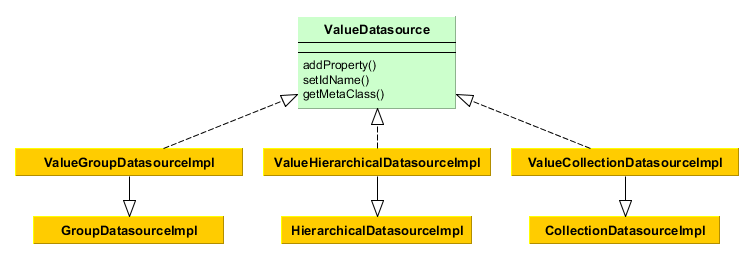4.5.3.3. Value Datasources
Value datasources enable execution of queries that return scalar values and aggregates. For example, you can load some aggregated statistics for customers:
select o.customer, sum(o.amount) from demo$Order o group by o.customerValue datasources work with entities of a special type named KeyValueEntity. This entity can contain an arbitrary number of attributes which are defined at runtime. So in the example above, the KeyValueEntity instances will contain two attributes: the first of type Customer and the second of type BigDecimal.
Value datasource implementations extend other widely used collection datasource classes and implement a specific interface: ValueDatasource. Below is a diagram showing the value datasource implementations and their base classes:

The ValueDatasource interface declares the following methods:
-
addProperty()- as the datasource can return entities with any number of attributes, you have to specify what attributes are expected by using this method. It accepts a name of the attribute and its type in the form of Datatype or a Java class. In the latter case, the class should be either an entity class or a class supported by one the datatypes. -
setIdName()is an optional method which allows you to define one of the attributes as an identifier attribute of the entity. It means thatKeyValueEntityinstances contained in this datasource will have identifiers obtained from the given attribute. Otherwise,KeyValueEntityinstances get randomly generated UUIDs. -
getMetaClass()returns a dynamic implementation of theMetaClassinterface that represents the current schema ofKeyValueEntityinstances. It is defined by previous calls toaddProperty().
Value datasources can be used declaratively in a screen XML descriptor. There are three XML elements corresponding to the implementation classes:
-
valueCollectionDatasource -
valueGroupDatasource -
valueHierarchicalDatasource
XML definition of a value datasource must contain the properties element that defines the attributes of KeyValueEntity instances that will be contained in the datasource (see the addProperty() method description above). The order of property elements should conform to the order of result set columns returned by the query. For example, in the following definition the customer attribute will get its value from o.customer column and the sum attribute from sum(o.amount) column:
<dsContext>
<valueCollectionDatasource id="salesDs">
<query>
<![CDATA[select o.customer, sum(o.amount) from demo$Order o group by o.customer]]>
</query>
<properties>
<property class="com.company.demo.entity.Customer" name="customer"/>
<property datatype="decimal" name="sum"/>
</properties>
</valueCollectionDatasource>
</dsContext>Value datasources are designed only for reading data, because KeyValueEntity is not persistent and cannot be saved by standard persistence mechanisms.